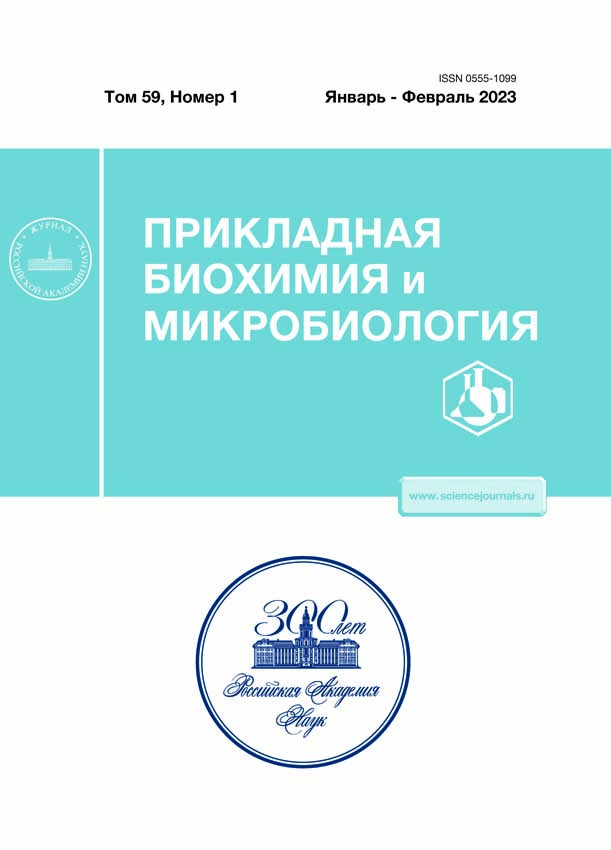Antifungal and Reactivation Activity of a Novel Glycine/histidine-rich Linear Peptide from Dog-grass (Elytrigiarepens (L.) Desv. ex Nevski) EARS
- Autores: Ryazantsev D.Y.1, Khodzhaev E.Y.2, Kuvarina A.E.3, Barashkova A.S.1, Rogozhin E.A.1,3
-
Afiliações:
- Shemyakin-Ovchinnikov Institute of Bioorganic Chemistry
- Lomonosov Moscow State University
- Gause Institute New Antibiotics
- Edição: Volume 59, Nº 1 (2023)
- Páginas: 38-45
- Seção: Articles
- URL: https://cardiosomatics.ru/0555-1099/article/view/674640
- DOI: https://doi.org/10.31857/S0555109923010099
- EDN: https://elibrary.ru/CVBXOI
- ID: 674640
Citar
Texto integral
Resumo
Using a combination of solid-phase extraction, affinity chromatography, and analytical reverse-phase HPLC, a new linear peptide was isolated from dog-grass (Elytrigia repens) ears, which does not contain cysteine residues. Identification of its primary structure by Edman automated degradation made it possible to reveal the presence of several polyglycine regions, each consisting of 6–8 residues, between which short fragments consisting of polar amino acid residues are localized. The C-terminal fragment of the molecule is a positively charged site enriched in arginine and histidine residues. The structural features of this peptide determine its functionality. Thus, checking the presence of antimicrobial properties in its recombinant analogue, obtained by heterologous expression in a prokaryotic system, made it possible to determine the MIC for the tested fungal cultures only at sufficiently high active concentrations (52–104 μM). However, this compound had regulatory properties: at a concentration of 25 μM, a reactivating effect was noted, which increased the level of survival of Saccharomyces cerevisiae to UV-irradiation. The data obtained expand the understanding of the functional features of plant defense peptides of an unusual structural type.
Palavras-chave
Sobre autores
D. Ryazantsev
Shemyakin-Ovchinnikov Institute of Bioorganic Chemistry
Autor responsável pela correspondência
Email: rea21@list.ru
Russia, 117997, Moscow
E. Khodzhaev
Lomonosov Moscow State University
Email: rea21@list.ru
Russia, 119234, Moscow
A. Kuvarina
Gause Institute New Antibiotics
Email: rea21@list.ru
Russia, 119021, Moscow
A. Barashkova
Shemyakin-Ovchinnikov Institute of Bioorganic Chemistry
Email: rea21@list.ru
Russia, 117997, Moscow
E. Rogozhin
Shemyakin-Ovchinnikov Institute of Bioorganic Chemistry; Gause Institute New Antibiotics
Email: rea21@list.ru
Russia, 117997, Moscow; Russia, 119021, Moscow
Bibliografia
- van der Weerden N.L., Bleackley M.R., Anderson M.A. // Cell. Mol. Life Sci. 2013. V. 70. № 19.P. 3545–3570. https://doi.org/10.1007/s00018-013-1260-1
- Tam J.P., Wang S., Wong K.H., Tan. W.L. // Pharmaceuticals (Basel). 2015. V. 8. № 4. P. 711–757. https://doi.org/10.3390/ph8040711
- SarikaIquebal M.A., Rai A. // Peptides. 2012. V. 36. № 2. P. 322–330. https://doi.org/10.1016/j.peptides.2012.05.012
- Das K., Datta K., Karmakar S., Datta S.K. // Protein Pept. Lett.2019. V. 26. № 10. P. 720–742. https://doi.org/10.2174/0929866526666190619112438
- Stec B. // Cell. Mol. Life Sci. 2006. V. 63. № 12. P. 1370–1385. https://doi.org/10.1007/s00018-005-5574-5
- Parisi K., Shafee T.M.A., Quimbar P., van der Weerden N.L., Bleackley M.R., Anderson M.A. // Semin.Cell. Dev. Biol. 2019. V. 88. P. 107–118. https://doi.org/10.1016/j.semcdb.2018.02.004
- Рогожин Е.А., Одинцова Т.И., Мусолямов А.Х., Смирнов А.Н., Бабаков А.В., Егоров Ц.А., Гришин Е.В. // Прикл. биохимия и микробиология. 2009. Т. 45. № 4. С. 403–409.
- Рязанцев Д.Ю., Рогожин Е.А., Цветков В.О., Яруллина Л.Г., Смирнов А.Н., Завриев С.К. // Доклады Академии Наук. 2019. Т. 484. № 1. С. 104–106.
- Odintsova T.I., Rogozhin E.A., Baranov Yu.V., Musolyamov A.Kh., Yalpani N., Egorov Ts.A., Grishin E.V. // Biochimie. 2008. V. 90. P. 1667–1673. https://doi.org/10.1016/j.biochi.2008.06.007
- Уткина Л.Л., Жабон Е.О., Славохотова А.А., Рогожин Е.А., Шиян А.А., Гришин Е.В., Егоров Ц.А., Одинцова Т.И., Пухальский В.А. // Генетика. 2010. Т. 46. № 12. С. 1–7.
- Slavokhotova A.A., Shelenkov A.A., Odintsova T.I. // Plant Mol. Biol. 2015. V. 89. № 3. P. 203–214. https://doi.org/10.1007/s11103-015-0346-6
- Odintsova T.I., Slezina M.P., Istomina E.A. // Biomolecules. 2020. V. 10. № 7. E. 1029. https://doi.org/10.3390/biom10071029
- Koetter U., Kaloga M., Schilcher H. // Part I. Planta Med. 1993. V. 59. № 3. P. 279–280. https://doi.org/10.1055/s-2006-959672
- Beydokthi S.S., Sendker J., Brandt S., Hensel A. // Fitoterapia. 2017. V. 117. P. 22–27. https://doi.org/10.1016/j.fitote.2016.12.010
- Кароматов И.Д. // Биология и интегративная медицина. 2017. № 6. С. 122–128.
- Provencher S.W., Glöckner J. // Biochemistry. 1981. V. 20. № 1. P. 33–37. https://doi.org/10.1021/bi00504a006
- Andreev Y.A., Kozlov S.A., Vassilevski A.A., Grishin E.V. // Anal. Biochem. 2010. V. 407. № 1. P. 144–146. https://doi.org/10.1016/j.ab.2010.07.023
- Воробьева Л.И., Рогожин Е.А., Ходжаев Е.Ю., Володяшкин Р.А., Самойленко В.А. // Микробиология. 2017. Т. 86. № 6. С. 684–695.
- Barashkova A.S., Rogozhin E.A. // BMC Plant Methods. 2020. V. 16. E. 143. https://doi.org/10.1186/s13007-020-00687-1
- Park C.J., Park C.B., Hong S.S., Lee H.S., Lee S.Y., Kim S.C. // Plant Mol. Biol. 2000. V. 44. № 2. P. 187–197. https://doi.org/10.1023/a:1006431320677
- Hilton H., Gaut B.S. // Genetics. 1998. V. 150. № 2. P. 863–872. https://doi.org/10.1093/genetics/150.2.863
- Gorinstein S., Jaramillo N.O., Medina O.J., Rogriques W.A., Tosello G.A., Paredes-Lopez O. // J. Protein Chem. 1999. V. 18. № 6. P. 687–693. https://doi.org/10.1023/a:1020610424625
- Czolpinska M., Rurek M. // Front Plant. Sci. 2018. V. 8. № 9. E. 302. https://doi.org/10.3389/fpls.2018.00302
- Pelegrini P.B., Murad A.M., Silva L.P., Dos Santos R.C., Costa F.T., Tagliari P.D. et al. // Peptides. 2008. V. 29. № 8. P. 1271–1279. https://doi.org/10.1016/j.peptides.2008.03.013
- Remuzgo C., Oewel T.S., Daffre S., Lopes T.R., Dyszy F.H., Schreier S. et al. // Amino Acids. 2014. V. 46. № 11. P. 2573–2586. https://doi.org/10.1007/s00726-014-1811-2
- Рогожин Е.А., Воробьева Л.И., Ходжаев Е.Ю., Герасимов Е.С. // Микробиология. 2019. Т. 88. № 2. С. 137–143.
Arquivos suplementares














